As you can imagine, wheels are an essential component of a bike.
Not only do bike wheels allow us to roll smoothly while cycling, but they also provide dampening from lumps and bumps as well as providing traction to the surface we’re riding.
Many cyclists don’t understand how to measure a bicycle wheel, or how to measure a bike tire so I put together this bicycle wheel size guide to help you determine your current wheel size and what size bike tires you need for your wheels.
Riding with wheels that are too big or small can cause damage to your bike, so pay attention to the steps below, and you won’t have any issues!
Ready to learn how to measure a bike wheel? Let’s hit the road.
Add a header to begin generating the table of contents
Based on how much time you want to allocate to measuring your bike wheel, you can take a few different approaches.
You could attempt first to contact the manufacturer or the shop where you purchased your bike. Retailers and manufacturers have a record of all measurements and sizing information.
But be warned, retailers can be a nightmare to get hold of and often take a long time to reply.
If you have a bike tire on your wheel, you can generally find required measurement information on the tire wall (side of tire – see picture below).
Tire walls usually display the size as determined by the European Tire and Rim Technical Organization, or ETRTO and will look something like the picture below.
Bike tire wall size pictureIf you can’t find the sizing on the wall of your tire, don’t panic. Below you’ll find several methods to help you understand how to measure your bike wheel.
Alongside understanding more about your bicycle’s rim, a few of the methods below will also help you determine which tire size your wheel needs.
These steps are beneficial in those cases where you do not have a bike tire or have custom wheels, as the measurements you seek may not be readily available to you.
Typically there are two main approaches for how to measure bicycle wheel size.
Just before we begin, if your wheel doesn’t have a tire fitted, click here to move on to the next step.
The quickest way to determine your bike wheel size is the standard method.
The standard method measures the tire width and tire diameter in inches.
Let’s start with a step by step guide on completing the standard method of bike wheel measuring:
Bike Wheel RadiusBike Tire Width
The most accurate way to measure bike tire size is through the ISO method.
ISO stands for the International Organization for Standardization, a measuring system that uses millimetres to gain the most accurate sizing possible for a bike tire.
Using this method, one measures the width of the tire and the inner diameter, or bead seat diameter.
Towards the end of the article, you’ll find a chart allowing you to compare the different ISO wheel sizes and what types of bike or vehicle each size of wheel is used with. Click here to view the chart.
Here is a step by step guide on how to measure a bike tire using the ISO standardization method.
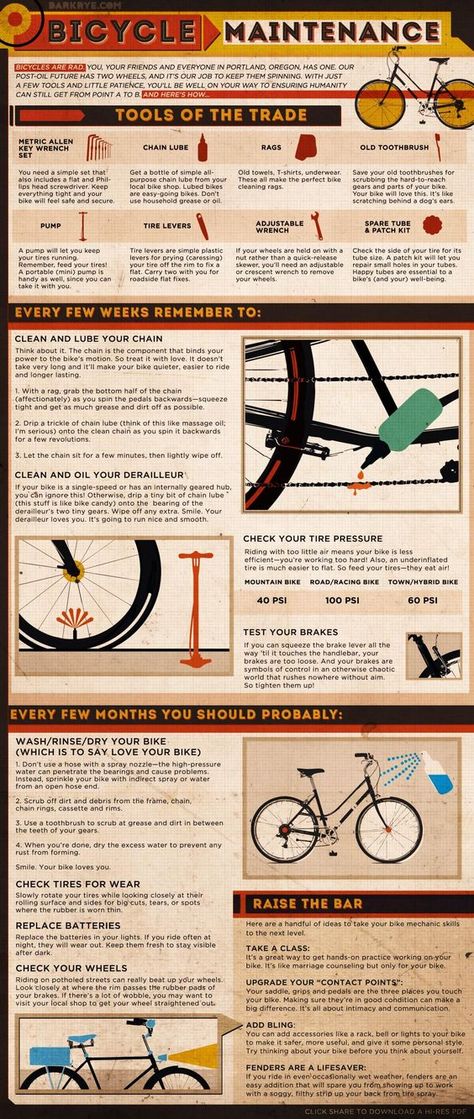
If you do not have your bike’s tire to hand, you can determine the tire size by measuring your bike’s rim width in millimetres as well.
Based on the average tire and wheel combinations currently on the market, the following charts illustrate the coinciding tire size and rim length.
This bike wheel has an ISO 622mm with an internal bead seat width of 15mm. Not all wheels will display their measurments!Many rims will display their size somewhere, but some rims may be missing this measurement.
If you cant find. measurement on your wheel’s rim, follow the easy steps below that will help you determine the appropriate tire sizes your rim can handle.

It’s important to note that these charts are based on average measurements; therefore, if possible it’s a good idea to double-check with your wheel’s manufacturer or retailer to confirm all compatible tire sizes.
It’s also important to consider the tire clearance on your fork and rear triangle. If you choose a tire that’s too wide you can end up damaging your frame and a tire that’s too thin can easily cause damage to your rim and inner tube.
| Tire Size Compatibility | Internal Rim Width |
|---|---|
| 23 - 25c | 13-15, 17-19mm |
| 25 - 28c | 13-15, 17-19, 20-21, 22-23mm |
| 30 - 33c | 17-19, 20-21, 22-23, 24-25mm |
| 33 - 35c | 17-19, 20-21, 22-23, 24-25mm |
| 38 - 40c | 20-21, 22-23, 24-25mm |
| 40 - 43c | 20-21, 22-23, 24-25mm |
| 43 - 45c | 22-23, 24-25mm |
| 45 - 48c | 22-23, 24-25mm |
| 48 - 50c | 24-25mm |
| Tire Size Compatibility | Internal Rim Width |
|---|---|
1.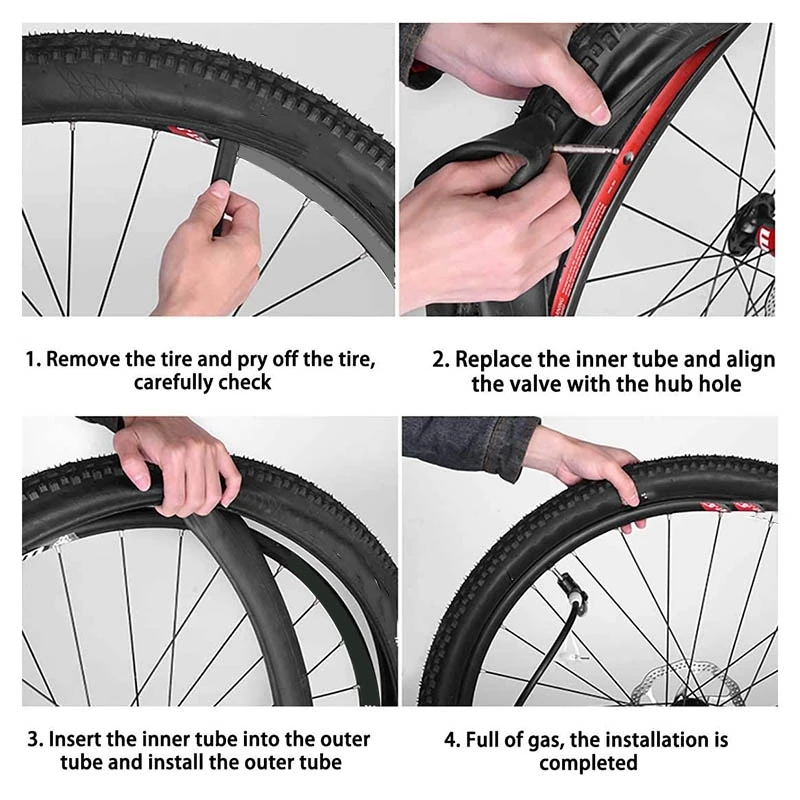 9" Tires 9" Tires | 19-23mm |
| 2.0" Tires | 19-24mm |
| 2.1" Tires | 19-28mm |
| 2.2" Tires | 20-30mm |
| 2.3" Tires | 21-33mm |
| 2.4" Tires | 23-34mm |
| 2.5-2.7" Tires | 25-35mm |
| 2.8-3.1" (plus) Tires | 22-23, 24-25mm |
The process of measuring a kid’s bike wheel and tire size follows similar steps to those shown above, but kid’s bike tires are measured in inches and are understandably smaller than those of an adult bike.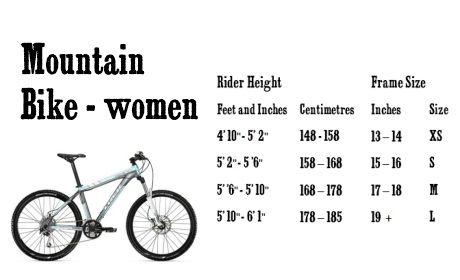
I’ve put together a simple guide for everything to do with kid’s bike sizing.
If you’re looking to measure the wheels on a kid’s bike, or are looking to determine which size bike is best for your kid, have a read of this guide, which includes all of the bike and wheel size charts you’ll need!
Follow the steps within this guide closely, as a poor fitting kids bike can put you child off cycling for good.
Measuring your wheel’s circumference for a bike computer is an important task that will determine the accuracy of the data your computer provides.
To simplify the steps required to measure your wheel’s circumference for a cyclometer, I’ve put together a simple bike wheel circumference guide.
These three simple methods will help you accurately measure your wheel’s circumference.
You won’t need any specialist equipment, apart from a measuring tape.
This may look interesting, but it's one of the easiest ways to measure the circumference of a bike wheel for a bicycle computer!Each type of road bike and mountain bike comes with a different set of average wheel sizes. In general, each of these sizes offer a unique set of benefits and drawbacks.
In general, each of these sizes offer a unique set of benefits and drawbacks.
The most common size wheel for a road bike is 700c, and has been the standard size for a number of years.
The 700 refers to the wheel’s diameter of 700 mm, while the “c” is an old French width code for tires.
With “a” characterized as the most narrow width and “d” at the widest, “c” refers to a generally wider size.
Mountain bike wheels come in three main sizes: 26 inches/559 wheels, 27.5 inches/650b wheels, and 29 inches/622 wheels.
The smaller, 26-inch mountain bike wheels were once considered standard size and are more lightweight and agile than larger sized wheels.
Despite their popularity in the past, 26-inch wheels are no longer the standard, as larger wheels have a better grip, traction, and durability and have therefore become more popular.
Both the 27. 5-inch and 29-inch wheels offer a smoother and more controlled ride while sacrificing some of the acceleration capabilities of a 26-incher.
5-inch and 29-inch wheels offer a smoother and more controlled ride while sacrificing some of the acceleration capabilities of a 26-incher.
ISO otherwise known as the International Organization for Standardization developed the ISO wheel size system, which is universal and simplifies the once confusing task of finding the right size wheel for your bike.
The ISO standardization system uses two different numbers, that can often be found printed on the tire or rim walls.
The second number displayed in ISO tire size is the important one and represents the wheel’s bead seat diameter (as shown in the ISO size chart below).
If your wheel rim or tire has no size markings, you can use this ISO wheel size chart after measuring your wheels, to cross-reference and understand more about the size of your bike’s wheels.
| ISO Bead Seat Diameter | Traditional Sizings | Applications | |
|---|---|---|---|
| 137mm | 5. 4" 4" | 8 x 11/4 | Wheelchairs |
| 152mm | 6" | 10 x 2 | Wheelchairs |
| 203mm | 8" | 12 1/2 x various | Scooters (children's) |
| 254mm | 10" | 14 x 2.00 | Various (children's) |
| 305mm | 12" | 16 x 1.75 - 16 x 2.125 | Folding bikes, some recumbents |
| 317mm | 12. 5" 5" | 16 x 1 3/4 | Schwinn (children's) |
| 337mm | 13.25" | 16 x 1 3/8 | Very rare bike tire |
| 340mm | 13.4" | 400 A | Folding bikes, European bikes (children's) |
| 349mm | 13.75" | 16 x 1 3/8 | Folding bikes, recumbents, bikes (children's) |
| 355mm | 14" | 18 x 1.5 - x 2.125 | Folding bikes, bikes (childrens) |
| 369mm | 14. 5" 5" | 17 x 1 1/4 | Moulton bikes |
| 390mm | 15.35" | 450 A | European bikes ( children's) |
| 406mm | 16" | 20 x 1.5 - x 2.125 | BMX, bikes (children's), folding bikes, recumbents |
| 419mm | 16.5" | 20 x 1 3/4 | Schwinn (children's) |
| 440mm | 17.3" | 500A | European bikes (children's), folding bikes |
| 451mm | 17. 75" 75" | 20 x 1 1/8; x 1 1/4; x 1 3/8 | Bikes (children's), BMX, recumbents, folding bikes |
| 457mm | 18" | 22 x 1.75; x 2.125 | Bikes (children's) |
| 490mm | 19.3" | 550 A | European road bikes (children's) |
| 501mm | 19.75" | 22 x 1 3/8, 22 x 1.00 | British bikes (children's) |
| 507mm | 20" | 24 x 1.5- x 2.125 | Mountain bikes (children's), cruisers |
| 520mm | 20. 5" 5" | 24 x 1, 24 x 1 1/8, 24 x 1 3/4 | Schwinn bikes |
| 540mm | 21.25" | 24 x 1 1/8, 24 x 1 3/8 (E.5), | British bikes (children's), wheelchairs, Japanese women's bikes |
| 547mm | 21.5" | 24 x 1 1/4, 24 x 1 3/8 (S-5) | British bikes (children's), Schwinn bikes (children's) |
| 559mm | 22" | 26 x 1.00- x 2.125, fatbike tires up to 5 inches wide | Mountain bikes, cruisers, fatbikes, Schwinn bikes |
| 571mm | 22.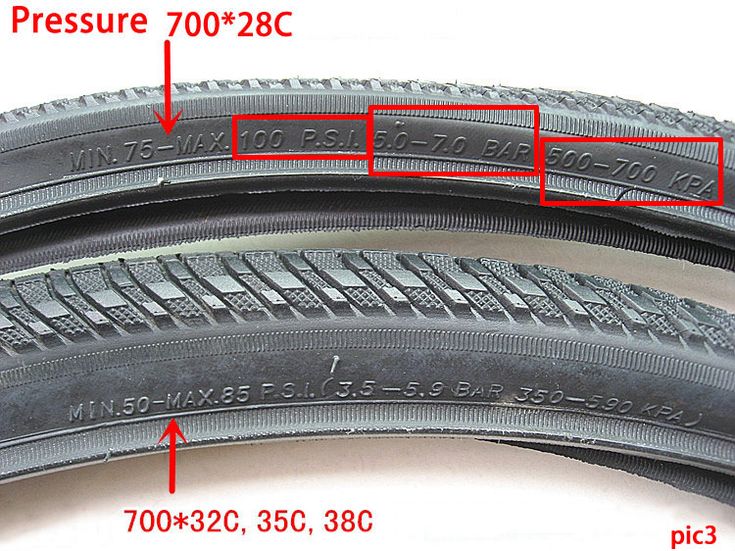 5" 5" | 26 x 1, 26 x 1 3/4, 650 C | Cannondale bikes, wheels for shorter cyclists, Schwinn bikes |
| 583mm | 22.95" | 700 D | GT bikes |
| 584mm | 23" | 650B, 26 x 1 1/2, 27.5 | French bikes, tandem and touring bikes, Raleigh & Schwinn mountain bikes |
| 590mm | 23.25" | 26 x 1 3/8 (E.A.3), 650 A | French & Italian bikes, English 3 speed bikes |
| 597mm | 23.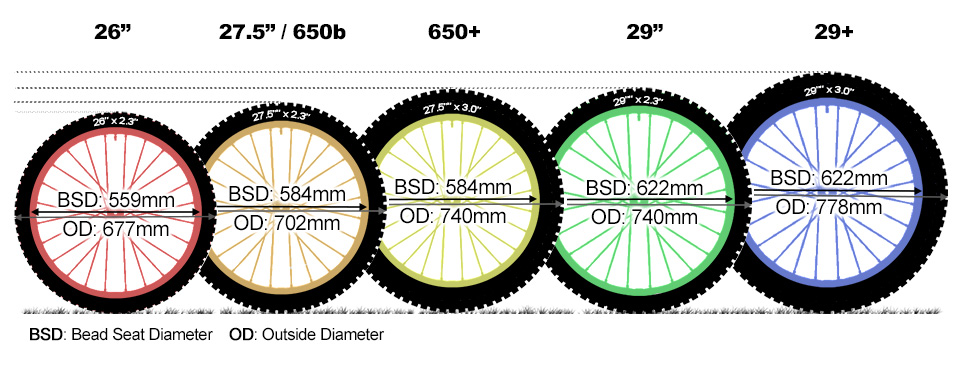 5" 5" | 26 x 1 1/4, 26 x 1 3/8 (S-6) | British bikes, Schwinn bikes |
| 599mm | 23.6" | 26 x 1.25, x 1.375 | Old US bikes |
| 622mm | 24.5" | 700 C, 28 x 1 5/8 x 1 1/2, 29 inch, 28 x 1 1/2 F.13 | All bike types, Canadian bikes (F.13), |
| 630mm | 24.8" | 27 x anything (not 27.5), 609mm | Rare Danish bikes, old road bikes |
| 635mm | 25" | 28 x 1 1/2, 700 B, 28 x 1 5/8 x 1 1/2 | European roadsters, old Swedish bikes |
| 686mm | 27" | 32 inch | Unicycles, Custom bikes |
| 787mm | 31" | 36 inch | Unicycles, Custom bikes |
How do you remove a bike wheel?
The process of removing a bike wheel varies based on whether you wish to remove the front or back wheel.
Remove the front wheel by releasing the brake, flipping the bike over, opening its quick-release or unscrewing the wheel nuts, and pulling it off the fork.
Remove the back wheel by shifting the chain down onto the smallest cog, opening the break, loosening your quick release or wheel nuts, then pull the rear derailleur back and remove the wheel at the same time.
Are bike wheels universal?
Bike wheels are not universal.
As bikes come in many different sizes, you’re limited with what size wheels you can use with a bike.
Usually, you’ll be able to make minor adjustments to the size of your wheels or tires, but wheels that are too big or small can easily damage your bicycle.
Can you put a road bike wheel on a mountain bike?
Putting road bike wheels on a mountain bike frame can be done and is a popular option for many commuters who cycle to work in the city but switch back to MTB wheels to hit the trails.
Just remember, as the designs of road and mountain bike wheels vary drastically, you’ll probably need to make adjustments elsewhere on your bike!
But yes, putting road bike wheels on a mountain bike is entirely possible!
Can you put a mountain bike wheel on a road bike?
For improved aerodynamics, the frame of a road bike is typically narrower and offers less wheel clearance than a mountain bike.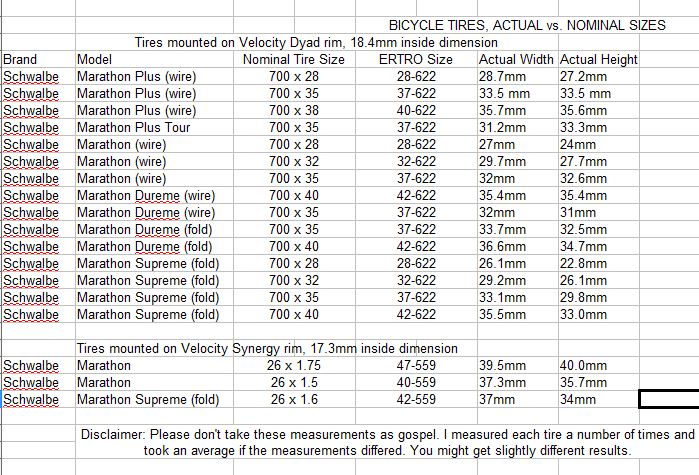
Due to the reduced wheel clearance road bikes typically offer, the wider tires and wheels that accompany a mountain bike are not usually compatible with road bike frames.
That being said, some slimmer 29-inch mountain bike wheels with narrow ties may fit on a road bike that takes 700c wheels.
However, cycling with wheels that are too big can end up causing damage to your bicycle.
If in doubt, don’t risk it.
I hope you found the content within this short article helpful. You should now understand exactly how to measure a bike wheel and how to measure a bike rim for a tire.
If I’ve left any of your questions unanswered, leave me a comment down below and I’ll get back to you straight away.
As always, make sure to use a good quality bike lock to secure your bike, when leaving it unattended.
If you’ve been wondering which size bike frame fits you best, have a read of this short guide, which will help you select the most suitable bike size in a few quick steps.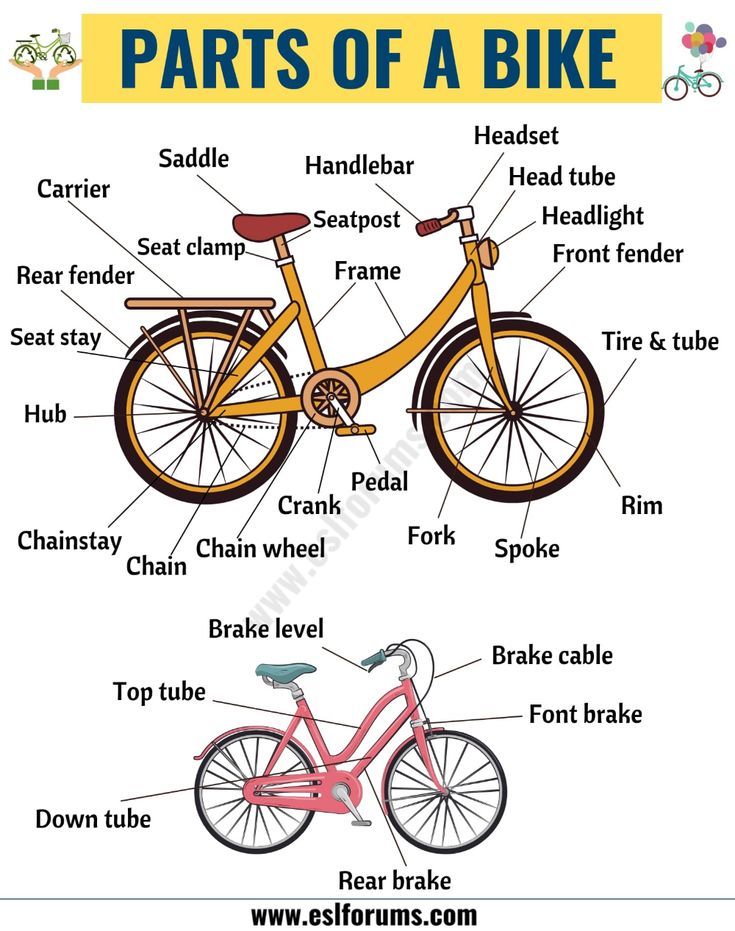
Lock it or lose it.
Ciao for now.
Your bike tire size isn’t just a number on a spec sheet or the tire’s sidewall, it’s an important part of your bike setup. Your tire’s diameter and width play a big role in how your bike handles and feels, how fast it rolls, and how well it grips the road or trail underneath. It’s an important bit of info to know, especially when it comes time to replace your tires, or if you’re looking to test out different sizing.
Generally, the larger the tire and wheel is in diameter, the faster you’ll roll, and the easier it’ll be to roll over obstacles. But smaller wheels may be preferred by some for height or maneuverability reasons. Similarly, the narrower the tire, the faster it rolls—plus it’s lighter—while a wider tire will offer greater traction and stability. Below, we explain bike tire sizes, tire styles, rider height, and more.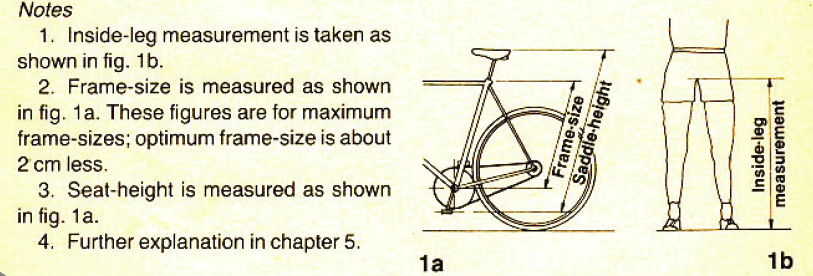
→ Get Bicycling All Access for the latest cycling and repair tips!
Bike tires come in all sorts of sizes, but it should be really, really easy to determine the size of yours. If you’re looking to purchase a replacement tire, simply look along the sidewall of your current tire (check both sides). You’ll see something printed like “700x25mm” or “29x2.30”—that’s your tire size.
The tire is marked with the size and recommended pressure.
Trevor RaabYou’ll also see the make and model of the tire, along with the recommended psi range for inflating your tire. Knowing how to measure your bike tire size is handy, but technically you shouldn’t need to measure anything in most circumstances because sizing is printed right on the tire.
The first number refers to the diameter of your tire. The “700” that you will commonly see as the first number—especially on road bikes, gravel bikes, fixies, and more—denotes a 700-millimeter wide diameter tire. Another somewhat common size is 650mm, which is typically found on smaller adult bikes.
The “700” that you will commonly see as the first number—especially on road bikes, gravel bikes, fixies, and more—denotes a 700-millimeter wide diameter tire. Another somewhat common size is 650mm, which is typically found on smaller adult bikes.
Accordingly, the second number refers to the metric width of the tire. Common widths for metric-based bike tires run anywhere from 23mm to as much as 48mm, or even more as gravel tires get increasingly wider.
Furthermore, you may see metric sizing listed as 700c or 650b. This is the older standard for sizing, where different letters represented different tire bead seat diameters. You will also see ISO sizing for tires, which is a more precise measurement for the tire bead seat diameter, though you usually won’t need to worry about it when picking out tires. For example, the ISO size of 622 corresponds with 700-size tires.
What’s a tire bead? Tire beads are the inner edges of the tire. They’re rounded and fit into the wheel rim to lock the tire into place once it’s inflated. A tire bead is said to be “seated” when it’s properly locked into place with the rim.
They’re rounded and fit into the wheel rim to lock the tire into place once it’s inflated. A tire bead is said to be “seated” when it’s properly locked into place with the rim.
A significantly smaller first tire size number, like 29 or 26, means the tire diameter is sized in inches. This sizing is common for mountain bikes, kid’s bikes, fat bikes, and some hybrids. Modern mountain bike tires are now either 29 inches or 27.5 inches in diameter; 26 inches is the older standard, though many of those bikes are still in use. Fat bike tires are typically either 27.5 or 26 inches. Kid’s bike tires are usually anywhere from 12 to 26 inches.
Trevor Raab
Trevor Raab
The second number for tire width with this sizing is also listed in inches. Common mountain bike tire widths now range from 1.85 to 2.6 inches. Plus-size tires (sometimes called mid-fats) for mountain bikes are wider than typical mountain bike tires, but aren’t quite fat tires; they range from 2. 8- to 3-inches wide. Actual fat bike tires require different (wider) rims. You’ll typically see fat bike tire widths range from 3 to 5.2 inches, and you may see their metric size listed as well.
Now 12% Off
$7 at Amazon
Credit: Slime$6 at Amazon
Credit: Kenda$15 at Amazon
Credit: Johnson and JohnsonNow 42% Off
$35 at Competitive Cyclist
Credit: ContinentalIn the event that the size has worn off of the side of your tire (it likely won’t), you could use a caliper or tape measure to measure tire width and diameter. Or, if the bike has no tires to begin with, you can measure your wheel rim diameter—in the middle of the wheel from end to end—as a starting point. You could also look up or contact the bike or wheel manufacturer to see which tire(s) will be compatible.
With adult bicycles, there are a few wheel size options, but it’s best to get a bike that’s sized to fit you well overall, as the frame size is more crucial to proper bike fit. Each bike company will have a size chart you can reference. Some bike companies do offer two wheel size options during purchasing, typically on smaller sized bikes, and that’s when you may need to decide between bike wheel sizes.
You may be able to put smaller wheels on a bike, depending on your frame and your brakes; rim brakes may not line up properly with a different size wheel. But you may also need to make other modifications (like crank length, for pedal clearance reasons). It’s often better, and easier, to have the right size bike from the start.
Kid’s bicycles, on the other hand, have a much wider range of tire sizes in order to accommodate a variety of heights. When you’re looking to purchase a new kid’s bike, the wheel size will correspond with the overall bike size, so it’s best to reference the bike manufacturer’s size chart. For example, the company Woom offers kid’s bikes in six different sizes and uses both height and inseam to help customers determine the right size bike and wheel combination.
A 28mm tire vs a 30mm tire, in the same fork.
Trevor RaabYou likely can, but there’s a limited range of tire-width compatibility for each bike. How wide you can go will depend on how much clearance you have with the tire installed between the fork arms, seatstays (or frame in general), and brakes (unless you have disc brakes). Beyond that, it’ll also depend on your wheel rims.
Here are the different styles you may encounter in your quest for new bike tires.
Charlie Layton
Clincher: This is the most common type of bike tire on the market now. Clincher tires use inner tubes to stay inflated and tire beads to attach to the rim. Inner tubes are not one-size-fits-all—you’ll need a tube that matches your tire diameter and width.
Tubeless: Tubeless tires are the newest style of bike tire. As its name suggests, tubeless tires don’t use inner tubes to stay inflated. Instead, they use tire sealant to create an airtight seal around the tire bead once inflated. If you’d like to convert to tubeless tires, you’ll need tubeless-compatible wheel rims.
Tubular: An older style of bike tire where the tire is glued to the rim. It’s less common now but is still utilized by some, including some pro road racers and cyclocross riders.
Beyond that, there are a variety of treads available for different sizes. Consider the kind of riding you usually do—do you ride pavement, gravel, both? A tire with more tread will offer better grip and is well suited for a variety of terrain, while a tire with little to no tread (like on many road bikes) will have less rolling resistance and will enable you to go faster.
And remember, when in doubt, your local bike shop is the best resource you have for figuring out all of your bike tire—and other bike—needs.
Jessica Coulon
Service and News Editor
When she’s not out riding her mountain bike, Jessica is an editor for Popular Mechanics. She was previously an editor for Bicycling magazine.
Nikolaev bicycle shop "Sportek"
Published: 01/27/2017
Edited: 06/01/2021
Sooner or later, almost every cyclist faces the question of replacing the rubber on the wheel or the cameras for them.
The easiest way, of course, is to look at the size of the tire currently installed on the bike (it is written on the side of it), and look for exactly the same. On some rims, their landing diameter and width are also written.
In life, everything is always a little more complicated and it often happens that the tire you like has a marking that is not entirely clear or does not match the marking on your rubber. Sometimes it is necessary to replace the old bicycle rubber, which has served for many years, with a more modern one.
What to do? You can’t put a tire on a bike over the Internet, but you don’t want to pay money just like that.
In this article, we will try to help you understand the markings on bicycle tires and find out which of them are interchangeable.
The first thing you need to know when choosing a tire is the size of the wheels. They are usually measured in inches, but sometimes in mm. There are not very many of them and the most common are 16, 18, 20, 24, 26, 27.5, 28, 29.
At the same time:
Further, what else you need to know is seat size (diameter) of the rim or BSD (English Bead Seat Diameter). It is the most important and determines the interchangeability of tires. If this number matches at the rim, tire, or tube, then that tire or tube fits those rims. And if the width of the new rubber can be changed, then the landing size will not change much.
If the size (numbers in mm) is written on the wheel (rim), for example, as in the photos above, they accurately indicate the fit size of the rim and its width, which is the main data for selecting the inner tube and tire for the wheel.
There are several types. The confusion in the designation of sizes began in the middle of the 20th century, and today Great Britain and France use their own designations for marking.
Previously, the sizing system was based on the outside diameter of the tires. It was measured in inches (24", 26", 28") or in millimeters (500, 650, 700, etc.).
Over time, this system lost its meaning, because different products with the same outer diameter wheels (together with the height of the tire) did not match the inner diameter (rim diameter) on which this tire was put on.There were also marketing moves of manufacturers, and the accuracy of translation and rounding of measurements in inches is lower than in millimeters.0003
To overcome these confusions and bring all sizes to the same standard, the International Organization for Standardization (ISO - International Organization for Standardization) has developed a universal system for designating tire sizes - ISO 5775 . This system was previously known as " ETRTO ". It was proposed by the organization of the same name: ETRTO (European Tire and Rim Technical Organization or in Russian: "European technical organization for rims and tires").
At first it was in the form of a number and a letter, for example, 700C - 700 the outer diameter of the tire is in mm. The letter determined the width from "A" - the narrowest to "D" - the widest.
Now the marking has acquired a more modern look. For example: 700 x 35C. Here the outer diameter of the tire is 700 mm and its width is 35 mm. The letter at the end indicates the inner (landing) diameter. In this case, "C" is 622 mm.
Note a very important nuance and paradox in inch sizes. Tire sizes can be specified as a decimal fraction, such as 26x1.75, or as a simple fraction, such as 26x1 3/4.
Mathematically, these fractions are equal: 1.75 = 1 3/4.
But, in terms of fit size and tire width in millimeters, this is not always the case, and the most unpleasant thing is that tires with such dimensions can be not interchangeable with .
And this circumstance should always be taken into account when purchasing a new bicycle tire.
In the table below, we have tried to collect the most common tire size designations in different systems and show their compatibility.
Perhaps not all dimensions encountered in life were taken into account, but if you have a tire with dimensions not listed in the table, try to estimate its dimensions based on similar nearest or similar dimensions.
| Rim bore size in mm according to ISO | Tire size in plain and decimal inches | French tire size | Tire size in mm according to ISO (width - bore) | Explanations |
| 681 | 22-681 | Sports track bike B-64 "Record" KhVZ (1958) | ||
| 642 | 28 x 1 5/8 x 1 1/2 | 700-28A | 28-642 | Obsolete size |
| 28 x 1 3/8 | 700-35A | 37-642 | ||
| 635 | 28 x 1 1/2 x 1 1/8 | 700-28B | 32-635 | American, English, Danish, Chinese, Indian road models |
| 28 x 1 1/2, 28 x 1 1/2 x 1 5/8 | 700-38B, 700B Standard | 40-635 | ||
| 28 x 1 5/8 x 1 1/2 | 44-635 | |||
| 630 | 27 x 7/8 | 22-630 | Road bikes, including older models | |
| 27 x 1 | 25-630 | |||
| 27 x 1 1/8 | 28-630 | |||
| 27 x 1 1/4 | 32-630 | |||
| 27 x 1 3/8 | 37-630 | |||
| 27 x all options | ||||
| 622 | 29 x all variants | 700C | This size was invented by marketers for tires with a bore diameter of 622 mm. | |
| 28 x decimal | 700C | For 622 mm tires | ||
| 28 x 3/4 | 700-18C 700x18C | 18-622 | ||
| 700-19C 700x19C | 19-622 | |||
| 28 x 3/4 | 700-20C 700x20C | 20-622 | ||
| 28 x 1 28 x 7/8 | 700-23C 700x23C | 23-622 | ||
| 28 x 1 | 700-25C 700x25C | 25-622 | ||
| 28 x 1 1/8, 28 x 1 5/8 x 1 1/8 | 700-28C 700x28C | 28-622 | ||
| 28 x 1.20 | 700-30C 700x30C | 30-622 | ||
| 28 x 1 3/4, 28 x 1.5 | 700x38C 700-40C | 40-622 | Road bikes: "Ukraine", "Minsk", "Sura", "Velta", "Aist" (111-321, 111-322) | |
| 28 x 1 1/2, 28 x 1 5/8 x 1 3/8 | 700C 700x35C 700x38C | 35-622 | Road bikes: "Ukraine", "Minsk", "Sura", "Velta", "Aist" | |
| 27 x 1 1/4, 28 x 1 5/8 x 1 1/4 | 700-32C 700x32C | 32-622 | Road and sports touring bikes, "Tourist", "Sport", "Sputnik" | |
| 28 x 1 5/8 x 1 1/4 | Obsolete Canadian designation F13 | |||
| 28 x 1. | 700-35C 700x35C | 35-622 | Road bikes | |
| 28 x 1.5 | 700x38C 700-38C 700-40C 700x40C | 40-622 | ||
| 28 x 1 3/8 x 1 5/8 | 37-622 | |||
| 28 x 1.6 | 700-42C 700x42C | 42-622 | ||
| 28 x 1.6 | 700-44C 700x44C | 44-622 | ||
| 28 x 1 5/8 x 1 3/4 | 700-45C 700x46C | 45-622 | ||
| 28 x 1.75, 28 x 1 5/8 x 1 3/4 | 700-47C 700x47C | 47-622 | ||
| 28 x 2.00 | 700-50C 700x50C | 50-622 | ||
| 600 | 22 (23, 24, 25, 27, 28, 30)-600 | Old Soviet sports and track bikes | ||
| 599 | 26 x 1.25, 26 x 1.375 | 32-599 | Very old American light bicycles. | |
| 26 x 1 7/8 | 47-599 | ZiF (Penza) 190-535 "Samson" | ||
| 597 | 26 x 1 1/4 (EA1) (England) | 32-597 | English old sports and club bikes. | |
| 26 x 1 3/8 (S-6) | 37-597 | Light bicycles of the American firm Schwinn. | ||
| 590 | 26 x 1 1/8 | 28-590 | Soviet bicycles ZiF (Penza) "Diana", "Prima", "Turn", "Relay", "Sura", "Breeze", "Temp" American and English 3 and 10 speed. | |
| 26 x 1 1/4 | 32-590 | |||
| 26 x 1 3/8 (E.A.3) (England) | 650A | 35-590 | ||
| 26 x 1 3/8 | 650-35A 650x35A | 37-590 | ||
| 26 x 1 5/8 | 44-590 | |||
| 587 | 700D | Old size on some GT models | ||
| 584 | 27. | 650x38B | 40-584 | French road bikes, touring bikes with cargo, tandems, some Raleigh (USA), old Schwinn mountain bikes |
| 26 x 1 1/2 | 650B | 37-584 | ||
| 27.5 x 1.5 | 40-584 | |||
| 27.5 x 1.65 | 44-584 | |||
| 27.5 x 1.75 | 47-584 | |||
| 27.5 x 2 | 52-584 | |||
| 27.5 x 2.1 | 54-584 | |||
| 27.5 x 2.25 | 57-584 | |||
| 27.5 x 2.3 | 60-584 | |||
| 27.5 x 2.4 | 62-584 | |||
| 27.5 x 2.8 | 70-584 | |||
| 571 | 26 x 3/4 | 650x20C | 20-571 | Triathlon, time trial, small road bikes, some French Peugeot bikes. |
| 26 x 7/8 | 650x23C | 23-571 | ||
| 26 x 1 | 650C | 23-571 | ||
| 26 x 1. | 47-571 | |||
| 26x1 3/4 (S-7) | Road Schwinn | |||
| 559 | 26 x 1.0 | 25-559 | Most mountain bikes. Classic landing diameter for 26 wheels. | |
| 26 x 1.25 | 32-559 | |||
| 26 x 1.35 | 35-559 | |||
| 26 x 1.4 | 37-559 | |||
| 26 x 1.5 | 40-559 | |||
| 26 x 1.6 | 44-559 | |||
| 26 x 1.75 26 x 1.75 x 2 | 47-559 | |||
| 26 x 1.95 | 50-559 | |||
| 26 x 2.00 | 52-559 | |||
| 26 x 2.10 | 54-559 | |||
| 26x2.15 | 55-559 | |||
| 26 x 2. | 57-559 | |||
| 26 x 2.3 | 60-559 | |||
| 26 x 2.4 | 62-559 | |||
| 26 x 3.0 | 75-559 | |||
| 26x3.7 | 95-559 | |||
| 26 x 4.00 | 100-559 | |||
| 26x4.5 | 115-559 | |||
| 26x4.8 | 120-559 | |||
| 547 | 24x1 1/4 | English children's and American firm Schwinn | ||
| 24x1 3/8 (S-5) | Schwinn American children's bicycles | |||
| 540 | 24 x 1 1/8 | 600A | 28-540 | Children's English and European bicycles, most wheelchairs |
| 24 x 1 1/4 | 32-540 | |||
| 24 x 1 3/8(E-5), 24 x 1 3/8 A | 37-540 | |||
| 533 | 24 x 1 1/2 | 37-533 | "Salute", "Altair", "Ervi", "Eaglet", "Erelyukas", "Swallow" ("Kregzdute", "Kregzhdute" - Siauliai bicycle factory "Vairas" Lithuania). Be careful when replacing as not all 24" tires will fit 533 wheels. | |
| 531 | 24 x 1 5/8 x 1 1/2 | 44-531 | ||
| 520 | 24x1 | 25-520 | Road wheels for children's bikes | |
| 507 | 24 x 1.5 | 40-507 | Children's mountain. "Salute", "Altair", "Ervi" | |
| 24 x 1.75 | 47-507 | |||
| 24 x 1.95 | 50-507 | |||
| 24 x 2.0 | 51-507 | |||
| 24 x 2.125 | 54-507 | |||
| 24 x 2.25 | 57-507 | |||
| 24 x 2.35 | 60-507 | |||
| 24 x 2. | 62-507 | |||
| 24 x 2.6 | 65-507 | |||
| 24 x 2.75 | 70-507 | |||
| 24 x 3.0 | 75-507 | |||
| 501 | 22 x 1.0 | 25-501 | European bikes | |
| 22 x 1 1/4 | 32-501 | |||
| 22 x 1 3/8 | 37-501 | |||
| 490 | 550-28A | 28-490 | European Road Kids Bikes | |
| 22 x 1 3/8 x 1 1/4 | 550-32A | 32-490 | ||
| 22 x 1 3/8 | 550-35A | 37-490 | ||
| 489 | 22 x 1.0 | 25-489 | European bikes | |
| 22 x 1 3/8 | 37-489 | |||
| 22 x 1 3/8 x 1 1/4 | 40-489 | |||
| 22 x 2. | 50-489 | |||
| 457 | 22 x 1.75 to 2.125 | Children's bicycles | ||
| 451 | 20 x 1 1/8 | 28-451 | BMX for light riders, light children's bikes, some ligerades. Wheels on some types of wheelchairs. | |
| 20 x 1 1/4 | 30-451 | |||
| 20 x 1 3/8 | 37-451 | |||
| 445 | 20 x 1 1/4 | 30-445 | "Schoolboy" (old Soviet models) | |
| 440 | 500-28A | 28-440 | European folding, children's bikes | |
| 500-35A | 37-440 | |||
| 20 x 1 1/2 | 500-38A | 40-440 | ||
| 438 | 20 x 1 3/8 | 37-438 | European bikes | |
| 20 x 1 3/8 1 1/2 | 40-438 | |||
| 432 | 20 x 2 1/2 | 40-432 | European bikes | |
| 428 | 20 x 2. | 54-428 | European bikes | |
| 419 | 20 x 1 3/4 | Schwinn American children's bicycles | ||
| 406 | 20 x 1.25 | 32-406 | Most BMX bikes, kids and folding models. "Venta" (folding model 175-811). "Stork" (folding, model 113-322) "Tisa-2", "Cross", "KAMA", "DESNA", "Schoolnik", "Velta Kama", "Dubisa" (Siauliai bicycle factory), "Eureka" and other folding and old Soviet models. Folding "Mustang" | |
| 20 x 1.35 | 35-406 | |||
| 20 x 1 3/4 20 x 1.5 | 40-406 | |||
| 20 x 1.75, 20 x 1.75 x 2 | 47-406 | |||
| 20 x 1.95 | 50-406 | |||
| 20 x 2.00 | 54-406 | |||
| 20 x 2. | 57-406 | |||
| 20 x 2.35 | 60-406 | |||
| 20 x 2.5 | 62-406 | |||
| 20 x 2.6 | 65-406 | |||
| 20 x 2.75 | 70-406 | |||
| 20 x 3.0 | 75-406 | |||
| 390 | 18 x 1 1/8 | 450-28A | 28-390 | Children's European bikes |
| 18 x 1 3/8 | 450-35A | 37-390 | ||
| 450-55A | 55-390 | |||
| 387 | 18 x 1 1/2 | 37-387 | Children's European bikes | |
| 369 | 17 x 1 1/4 | 32-369 | Bicycles Alex Moulton | |
| 355 | 18 x 1 1/8 | 28-355 | Children's bicycles | |
| 18 x 1. | 32-355 | |||
| 18 x 1.35 | 35-355 | |||
| 18 x 1.5 | 40-355 | Birdy folding bikes. | ||
| 18 x 1.6 | 42-355 | Children's bicycles | ||
| 18 x 1.75 | 47-355 | |||
| 18 x 1.95 | 50-355 | |||
| 18 x 2.0 | 54-355 | |||
| 18 x 2.125 | 57-355 | |||
| 349 | 16 x 1 1/8 | 28-349 | Old Moulton, Brompton and other folding bicycles, ligerade front wheels, children's bicycles. | |
| 16 x 1 1/4 16 x 1.25 | 32-349 | |||
| 16 x 1.35 | 35-349 | |||
| 16 x 1 3/8 | 37-349 | |||
| 340 | 400-30A | 28-340 | Children's European bikes | |
| 16 x 1 3/8 x 1 1/4 | 400-32A | 32-340 | ||
| 16 x 1 3/8 | 400-35A | 37-340 | ||
| 16 x 1 5/8 | 400A | 44-340 | ||
| 335 | 16 x 1 3/8 | Children's Polish bicycles | ||
| 330 | 16 x 1 1/2 | 400-38B | 40-330 | Children's bicycles |
| 317 | 16 x 1 3/4 | Schwinn American children's bicycles | ||
| 305 | 16 x 1. | 40-305 | Children's bicycles, folding, touring and some ligerades. | |
| 16 x 1.75 | 47-305 | |||
| 16 x 1.95 | 50-305 | |||
| 16 x 2.0 | 54-305 | |||
| 16 x 2.125 | 57-305 | |||
| 16 x 2.5 | 62-305 | |||
| 298 | 14 x 1 1/4 | 350-32A | 32-298 | Carriages, children's bikes, balance bikes |
| 288 | 14 x 1 3/8 | 350A, 350-35A | 37-288 | Children's bicycles, balance bikes |
| 14 x 1 5/8 | 350-38A | 40-288 | ||
| 14 x 1 5/8 x 1 3/8 | 350-42A | 44-288 | ||
| 14 x 1.75 | 47-288 | |||
| 279 | 14 x 1 1/2 | 350-38B | 40-279 | Children's bicycles, balance bikes |
| 254 | 14 x 1. | 40-254 | Children's bicycles, balance bikes | |
| 14 x 1.75 | 47-254 | |||
| 14 x 2 | 54-254 | |||
| 239 | 12 1/2 x 1 3/8 x 1 1/4 | 300-32A 300x32A | 32-239 | Children's bicycles, balance bikes |
| 205 | 12 1/2 x 2 1/4 | 56-205 | Children's bicycles "KVD", balance bikes, sometimes suitable for baby carriages ("Dutik" tires) | |
| 203 | 12 x 1.75 12 1/2 x 1.75 12 1/2 x 1.9 | 47-203 | Small children's bicycles, balance bikes, baby carriages | |
| 12 x 1.95 | 54-203 | |||
| 12 x 2.0 | 50-203 | |||
| 12 x 2.125, 12 1/2 x 2 1/4 R | 57-203 | |||
| 12 1/2 x 2 1/4 | 62-203 | |||
| 176 | 55-176 | Tires for tricycles, scooters, balance bikes for small children, wheelbarrows and carts, prams | ||
| 152 | 10 x 2 | 54-152 | ||
| 137 | 8 x 1 1/4 | 32-137 |
Tire width selection is more flexible than rim diameter.
Rim widths are measured and marked in millimeters as shown in the figure at the beginning of the article.
How to measure the width of the rim is described in a separate article here.
| Rim width in mm | Tire width in mm and inches | Bicycle type |
| 13 | 18 - 25 mm (1") | road and cyclocross models |
| 15 | 23 - 32 mm (1" - 1.25") | |
| 17 | 25-37 mm (1" - 1.5") | light cross-country and hybrid models |
| 18 | 28 - 44 mm (1.1" - 1.75") | heavy cross-country and hybrid models |
| 19 | 28 - 60 mm (1.1" - 2.35") | MTB (mountain bikes, mountain bikes) |
| 20 | 28 -47 mm (1. | cycling and light extreme |
| 21 | 35 - 50 mm (1.4" - 2") | |
| 23 | 40 - 50 mm (1.5" - 2.1") | extreme cycling |
| 25 or more | 44 - 57 mm (1.75" - 2.25") | |
| 32 | 75 mm (3") and over |
This table shows guide data for a medium bike. Use it not as a dogma, but as a guideline for selection.
Some manufacturers give their own tables for the tires they produce, according to which they need to be selected for their wheel.
The tire width affects rolling and grip. The wider - the better the grip, cornering control, but the worse the roll.
It is considered optimal if the width of the tire is 1.5-2.1 times wider than the inner width of the rim. It is possible and 2.5 times, but this is already an amateur.
The tire-to-rim width ratio affects the tire's cornering behavior. Too wide tires mounted on a narrow rim can simply break. will have a pear-shaped profile.
Further, if the wheel is equipped with toothy rubber, then the side spikes on the tread will not be where they should be for sure grip in the turn.
With wide tires on a narrow rim, the side studs will be too high and will not hold properly in the turn.
On narrow tires with a wide rim, the spikes will be from below and with a good slope, the bike will ride on the sidewall, and she is bald.
Below is the famous table compiled by Georg Boeder of tire and rim width recommendations
fractional inches) here.
Comments (132)
x
Every bicycle wears out a little as it is used. This also applies to bicycle tires, which are very important to change in a timely manner. To do this, you need to know the tire markings. It is necessary to be guided by the parameters set by the manufacturers. It should be borne in mind that the wheel, or rather its size, directly affects the parameters of a bicycle tire.
How to determine parameters
EC
Most modern manufacturers use the European marking according to the ETRTO classification. This abbreviation stands for European Tire and Rim Technical Organization.
The following indicators apply here:
By the way, Soviet-made bicycle tires had reverse double markings. The inner diameter of the tire was in first place, the width of the chamber was indicated in the second place.
To date, the marking adopted in Europe is considered the most accurate and convenient in comparison with the rest.
Dimensioning in inches
This application of indicators also consists of two numbers listed through a multiplication sign or a fraction. For example, if the values are 28 x 1.4, then 28 equals the outer diameter of the tire, and 1.4 is its intended width in inches.
French
French marking may have the following meaning: 700 x 35C. Local manufacturers put down numerical values for width, inner diameter and outer diameter. Therefore, in this case, the figure 700 is the approximate value of the outer diameter. In turn, the designation "C" determines the inner diameter. The indicator decreases with the movement of the letter to the beginning of the alphabet. Therefore, "A" is the smallest, and "D" is the largest. In the above example, the value "C" defines an internal diameter of 622 mm. This system of recording values is not applicable to all bicycles (for example, not used for mountain bikes).
How to determine the bore diameter?
So, if you need a bicycle tire, you should initially select the diameter of the wheel rim.
Diameter size 28 and 29 equals 622 mm. These two tires differ only in height and thickness.
27.5-inch wheels require a bore diameter of 584 and 590 mm.